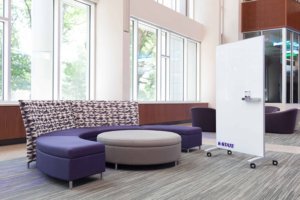Why is an Open Concept Office Furniture Effective?

With so many companies working to promote teamwork and boost productivity, open-plan offices are a popular option.
In today’s business, where collaboration, creativity, and rapid communication are paramount, closed spaces and separate rooms no longer meet the needs of companies.
Now we want to know: Why is open concept office furniture effective?
Open concept office furniture is effective because it encourages collaboration, improves communication, and maximizes space efficiency, creating a more flexible and connected work environment.
The open-concept office design trades conventional barriers like walls and office doors for open space, with everyone working closely together. The benefits of an open-concept office range from reduced costs in overhead, better customization, to more effective management and collaboration.
Weighing the advantages against potential drawbacks as well as proper implementation, the open-concept office can be quite effective.
The Main Benefits of Open-Concept Office Space
Makes Collaboration Easier
One of the key advantages of an open-concept office is the convenience and ease of communication and collaboration amongst employees. Since workers are not separated by cubicle walls or physical offices, coworkers can easily gather at a common table or work area.
In this type of design, walls and partitions are eliminated, which encourages spontaneous conversations and greater interaction among team members.
In this space, ideas and information are exchanged more quickly and easily.
For example, an open-concept office allows a programmer and web designer to easily exchange ideas and achieve the best results for the project.
This advantage is very valuable and practical for dynamic and creative businesses.
Employees can be more productive since they can easily share ideas and receive frequent feedback on projects and tasks from others. The increased collaboration makes an open-concept office ideal for project-driven work environments as well as co-working spaces for freelancers.
Saving Money on Overhead Costs
Reducing overhead costs is another benefit of open-concept office design. There is no need to purchase expensive cubicle workstations or traditional office desks.
Businesses can invest their money into more important areas like product development and marketing.
 Small businesses can benefit well from an open-concept office. Rather than spending funds to obtain an entire building or floor, they can start by renting a small, open-concept office, then buy some tables and office chairs and get to work.
Small businesses can benefit well from an open-concept office. Rather than spending funds to obtain an entire building or floor, they can start by renting a small, open-concept office, then buy some tables and office chairs and get to work.
Boosting Creativity and Innovative Thinking
In an open-concept office, team members can work together, creating an environment for brainstorming and idea generation.
Informal discussions in these spaces and the comfort and intimacy among members lead to creativity and innovation.
In these spaces, employees in different departments also communicate more easily with each other.
As a result, they can share their perspectives and create solutions to challenges that arise along the way.
Optimized Use of Office Space
For businesses like startups that face budget constraints, office design should prioritize efficiency and maximum use of space.
Arranging Houston office furniture in open-concept offices allows companies to accommodate more employees in a limited space.
In this design, by eliminating walls and separate offices, businesses can provide teams with spaces with diverse uses.
Additionally, this type of design allows companies to easily change the configuration and layout of the space, giving them more flexibility to grow their team and change their work needs.
Building a Strong Workplace Community
One of the advantages of open-plan offices is that it fosters a sense of community among employees.
People who work closely together tend to have stronger relationships, which increases interaction and a sense of collaboration.
In such an environment, newly hired people also adapt to the team more quickly.
This will strengthen the work culture in shared spaces.
As a result, open-concept offices not only increase efficiency and productivity but also strengthen employees’ sense of belonging and commitment to the organization.
Easier Employee Management
Without barriers like walls or office doors, it’s easier for supervisors to monitor workers and respond to problems. Managers can stroll around the open-concept office and communicate easily with employees, checking their progress on assignments. This can also improve productivity since workers know their managers are watching them. They’ll slack off less under increased supervision.
Employees will also benefit since they have more convenient access to management throughout the day. They don’t have to leave their workspace to walk to their manager’s office. Employees may feel more relaxed approaching management in this open-concept format.
Allows for a Customized Space
Increased flexibility in how the office space can be laid out is among the open-concept advantages. This type of floor plan allows a business to decide the best way to group teams to accomplish goals. If project teams grow, tables can be moved around, allowing for the most effective collaboration. Managers can even change the setup on short notice when necessary. This wouldn’t be possible with fixed walls.
 A custom open-concept office plan also allows for better amenities. Offices can be trendier, offering cafes, game rooms, or even relaxing furniture for workers to use for breaks and lunches.
A custom open-concept office plan also allows for better amenities. Offices can be trendier, offering cafes, game rooms, or even relaxing furniture for workers to use for breaks and lunches.
Proper Implementation is Key
While open-concept offices are designed to encourage collaboration and efficiency, poor implementation often leads to the opposite result.
U.S. companies have been swapping office cubicles for open-concept offices for over a decade now. Today, more than seventy percent of employees work in shared spaces. Some are fans; many aren’t.
The abundance of open-concept offices has allowed for considerable research on which elements actually boost productivity and happiness and which do not. Many studies show that open-concept offices can stifle productivity, increase both stress and sickness, and, ironically, result in less face-to-face interaction. Some suggest, however, that if implemented “correctly,” open-concept plans will boost productivity and happiness as intended.
So, what have we learned about open-concept offices that can be used to improve upon the model?
Open-Concept Offices Work Best When They Reflect Your Core Values
A survey conducted by the Harvard Business Review discovered that offices were more productive when they reflected what the companies do and how they work. Workers in these offices reported greater happiness and that they worked well together and independently.
 To reflect core values in an open-concept office, as an example, a creative agency could improve ideation with an artistic aesthetic. They can use color and light to stimulate employees, incorporating whimsical, contemporary spaces for independent work and relaxed meetings. A law firm, on the other hand, might decide to support its primary purpose of private meetings with clients. Its open-concept office would feature private spaces with frosted glass walls and demountable walls, creating a welcoming feel at the same time maintaining privacy.
To reflect core values in an open-concept office, as an example, a creative agency could improve ideation with an artistic aesthetic. They can use color and light to stimulate employees, incorporating whimsical, contemporary spaces for independent work and relaxed meetings. A law firm, on the other hand, might decide to support its primary purpose of private meetings with clients. Its open-concept office would feature private spaces with frosted glass walls and demountable walls, creating a welcoming feel at the same time maintaining privacy.
Distractions are an Open-Concept’s Downfall
Open concepts increase visibility for coworkers, who can see what others are working on and help when needed. That’s a positive. Gemma Irving, a researcher at the University of Queensland, conducted a study of open-concept offices to see if they irritated or inspired employees. She discovered that “Employees valued getting instant help from their team members in the open-plan. Instead of distractions or having privacy issues, team members could access shared whiteboards, flipcharts, and drawings, helping coordination and improving team productivity.”
However, and this is key, those successful open-concept offices included ways for coworkers to guard their individual work time. Methods as simple as “do not disturb” signs posted at their desks when needed. Other research suggests that when private spaces, rooms, and cubes are readily accessible for private work, employees will be happier with their open-concept environment.
Booking Conference Rooms Must Be Easy
Since open-concept offices can get noisy, the ability to book private, closed-door space when needed is critical in enabling your employees to have privacy when needed. The key is ensuring you accommodate your teams by having enough rooms. For open-concept workspaces, generally, one conference room for every ten employees is ideal.
An internal scheduling app is perfect for streamlining the booking process. This allows employees to see which rooms are available at a given time. (You could even consider adding a scheduling tablet outside the room, which can digitally alert employees to availability and allow them to book time on the spot.)
Leave Room for Change and Growth
An essential aspect of having an open-concept office is being open to suggestions and change. A genuine open-door policy and listening to staff feedback are the ideal way to incorporate the qualities of this type of design and the work culture it brings.
 Be sure to leave space for growth! Otherwise, you’ll grow right out of the very space you invested your time, money, and energy in much sooner than you realize.
Be sure to leave space for growth! Otherwise, you’ll grow right out of the very space you invested your time, money, and energy in much sooner than you realize.
Functional Solutions to Address Open-Concept Office Challenges
- Using phone booths and chat rooms: Studies have shown that 70% of employees in open-plan offices complain about noise and distractions.
This can lead to reduced productivity and increased stress.
A solution to this problem: creating phone booths or private spaces for phone calls and short meetings can help reduce distractions and increase focus.
- Design quiet zones: Research shows that each interruption in work can take up to 23 minutes to return to full focus.
This is especially noticeable in noisy environments.
The solution to this challenge is to allocate quiet spaces for tasks that require high concentration, such as study rooms or soundproof spaces, which can increase productivity.
- Using soundproof partitions: According to statistics, 70% of employees in open-plan offices feel they don’t have enough privacy.
This can lead to decreased job satisfaction and increased stress.
Using furniture with sound-absorbing materials, such as chairs with special foam or tables with soft surfaces, can help reduce noise and partially solve this challenge.

John Ofield is the owner of Collaborative Office Interiors. Houston’s trusted source for modern and commercial office furniture, office cubicles, demountable walls, office desks and tables, and complete workspace solutions. With more than 40 years of experience, he combines deep product knowledge with hands-on space-planning expertise to create ergonomic, productivity-focused work environments for businesses across Southeast Texas.


